Climate Trends and Attribution Analysis of Runoff Changes in the Songhua River Basin from 1980 to 2022 Based on the Budyko Hypothesis
Abstract
1. Introduction
- Detect long-term trends, abrupt changes, persistence, and periodic features in key hydroclimatic variables using MK, Pettitt, R/S, and wavelet analyses;
- Evaluate the evolution of aridity and its implications for hydrological regimes;
- Quantify the relative contribution of climate change and anthropogenic impacts to runoff variations using a modified Budyko attribution method; and
- Discuss the broader implications of runoff variability in the context of hydrological sustainability and methodological limitations.
2. Overview of the Study Area
3. Data and Methods
3.1. Data Source and Processing
3.1.1. Meteorological Data
3.1.2. Hydrological Data
3.2. Methods
3.2.1. Climate Tendency Rate
3.2.2. Mann–Kendall Abrupt Change Detection
3.2.3. Pettitt Abrupt Change Detection
3.2.4. R/S Analysis
3.2.5. Wavelet Analysis
3.2.6. Wavelet Coherence Analysis
3.2.7. Aridity Index
3.2.8. A Modified Budyko Attribution Method
4. Results
4.1. Time Trend and Abrupt Change
4.1.1. Trend Analysis
4.1.2. Abrupt Change
4.2. Sen’s Slope Trends
4.3. Hurst Value
4.4. Periodic Changes
4.5. Characteristics of Runoff Variation
4.6. Attribution Analysis of Changes in Runoff
5. Discussion
5.1. Characteristics of Climate Change
5.1.1. Integrated Spatial Coherence, Drivers, and Regime Shifts
5.1.2. Inter-Basin Comparison of Persistence, Cyclicity, and Hydroclimatic Mechanisms
- (1)
- Temperature: Persistent Warming and Multi-Scale Coupling
- (2)
- Precipitation: Weak Persistence and Strong Spatiotemporal Nonstationarity
- (3)
- Evapotranspiration: Joint Control by Warming and Vegetation Greening
- (4)
- Relative Humidity: Stable Cold-Season Drying and Snowpack Impacts
- (5)
- Sunshine Duration: Radiation Recovery and Feedbacks
- (6)
- Inter-basin Linkages and Differential Responses (Direct Response to Reviewer)
- (7)
- Linking Statistical Signals to Physical Mechanisms
- (8)
- Implications for Basin Management
5.2. Characteristics of River Discharge Variations in a Watershed
5.3. Impact of Meteorological Factors on Runoff and Basin-Scale Dry-Wet Transition Characteristics
5.4. Limitations of Budyko Hypothesis
6. Conclusions
- 1.
- Climatic Trends and Hydrological Regime Shifts:
- 2.
- Runoff Variation and Change Points:
- 3.
- Budyko-Based Attribution of Runoff Changes:
- 4.
- Hydroclimatic Risks and Drying Trends:
- 5.
- Implications for Water Resources Management:
Author Contributions
Funding
Institutional Review Board Statement
Informed Consent Statement
Data Availability Statement
Acknowledgments
Conflicts of Interest
Appendix A
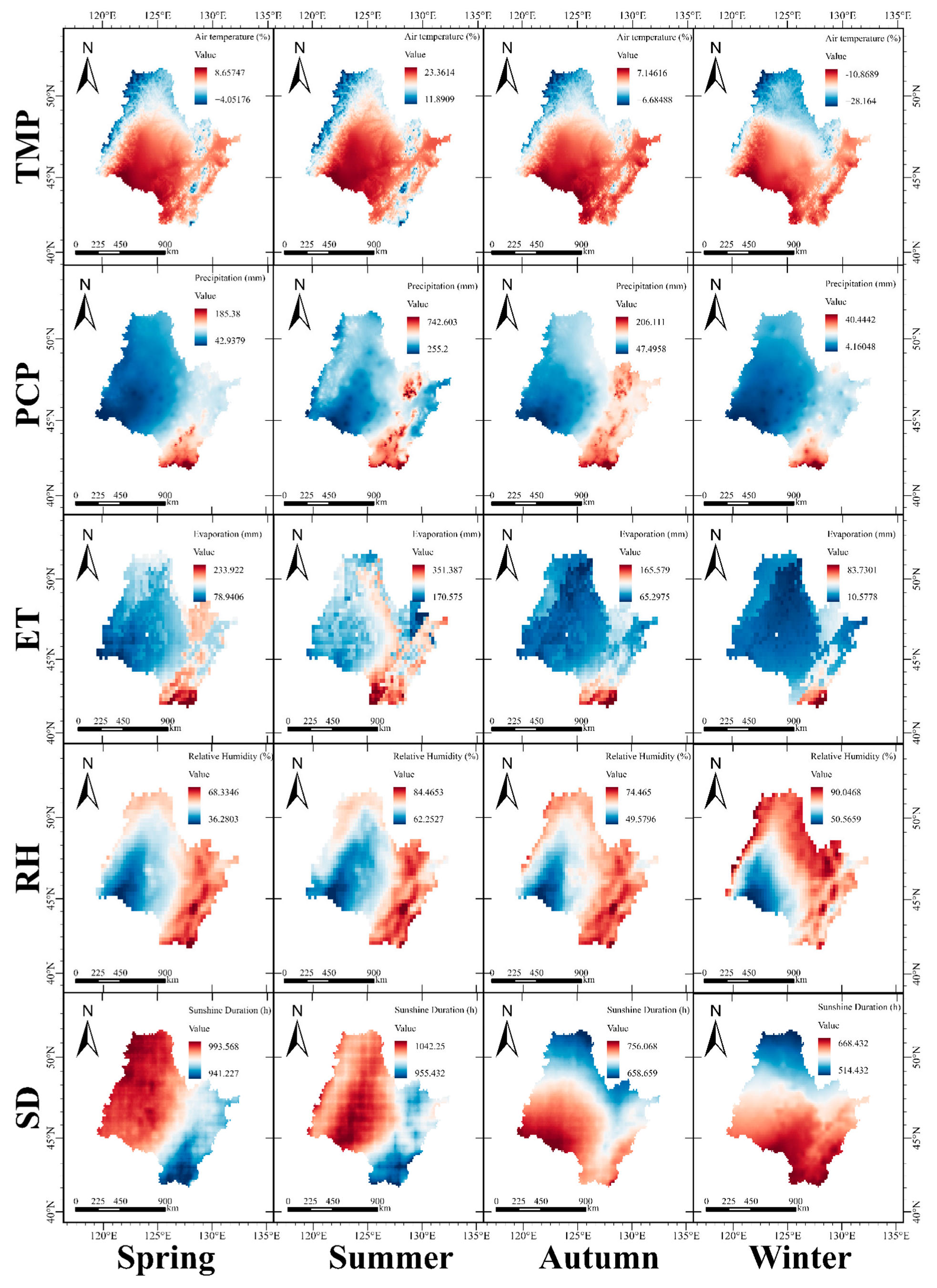

References
- Montanari, A.; Young, G.; Savenije, H.H.G.; Hughes, D.; Wagener, T.; Ren, L.L.; Koutsoyiannis, D.; Cudennec, C.; Toth, E.; Grimaldi, S.; et al. “Panta Rhei—Everything Flows”: Change in Hydrology and Society—The IAHS Scientific Decade 2013–2022. Hydrol. Sci. J. 2013, 58, 1256–1275. [Google Scholar] [CrossRef]
- Gu, X.; Bai, W.; Li, J.; Kong, D.; Liu, J.; Wang, Y. Spatio-Temporal Changes and Their Relationship in Water Resources and Agricultural Disasters across China. Hydrol. Sci. J. 2019, 64, 490–505. [Google Scholar] [CrossRef]
- Piao, S.; Liu, Q.; Chen, A.; Janssens, I.A.; Fu, Y.; Dai, J.; Liu, L.; Lian, X.; Shen, M.; Zhu, X. Plant Phenology and Global Climate Change: Current Progresses and Challenges. Glob. Change Biol. 2019, 25, 1922–1940. [Google Scholar] [CrossRef] [PubMed]
- Huang, J.; Yu, H.; Dai, A.; Wei, Y.; Kang, L. Drylands Face Potential Threat under 2 °C Global Warming Target. Nat. Clim. Change 2017, 7, 417–422. [Google Scholar] [CrossRef]
- Jiang, C.; Xiong, L.; Wang, D.; Liu, P.; Guo, S.; Xu, C.-Y. Separating the Impacts of Climate Change and Human Activities on Runoff Using the Budyko-Type Equations with Time-Varying Parameters. J. Hydrol. 2015, 522, 326–338. [Google Scholar] [CrossRef]
- Ye, X.; Zhang, Q.; Liu, J.; Li, X.; Xu, C. Distinguishing the Relative Impacts of Climate Change and Human Activities on Variation of Streamflow in the Poyang Lake Catchment, China. J. Hydrol. 2013, 494, 83–95. [Google Scholar] [CrossRef]
- Budyko, M.I. Climate and Life; Academic Press: Cambridge, MA, USA, 1974. [Google Scholar]
- Zhang, L.; Hickel, K.; Dawes, W.R.; Chiew, F.H.S.; Western, A.W.; Briggs, P.R. A Rational Function Approach for Estimating Mean Annual Evapotranspiration. Water Resour. Res. 2004, 40, W02502. [Google Scholar] [CrossRef]
- Cong, Z.; Zhang, X.; Li, D.; Yang, H.; Yang, D. Understanding Hydrological Trends by Combining the Budyko Hypothesis and a Stochastic Soil Moisture Model. Hydrol. Sci. J. 2015, 60, 145–155. [Google Scholar] [CrossRef]
- Rouholahnejad Freund, E.; Kirchner, J.W. A Budyko Framework for Estimating How Spatial Heterogeneity and Lateral Moisture Redistribution Affect Average Evapotranspiration Rates as Seen from the Atmosphere. Hydrol. Earth Syst. Sci. 2017, 21, 217–233. [Google Scholar] [CrossRef]
- Xu, X.; Yang, D.; Yang, H.; Lei, H. Attribution Analysis Based on the Budyko Hypothesis for Detecting the Dominant Cause of Runoff Decline in Haihe Basin. J. Hydrol. 2014, 510, 530–540. [Google Scholar] [CrossRef]
- Li, Z.; Ning, T.; Li, J.; Yang, D. Spatiotemporal Variation in the Attribution of Streamflow Changes in a Catchment on China’s Loess Plateau. CATENA 2017, 158, 1–8. [Google Scholar] [CrossRef]
- Lv, X.; Zuo, Z.; Ni, Y.; Sun, J.; Wang, H. The Effects of Climate and Catchment Characteristic Change on Streamflow in a Typical Tributary of the Yellow River. Sci. Rep. 2019, 9, 14535. [Google Scholar] [CrossRef]
- Hamed, K.H.; Ramachandra Rao, A. A Modified Mann-Kendall Trend Test for Autocorrelated Data. J. Hydrol. 1998, 204, 182–196. [Google Scholar] [CrossRef]
- Pettitt, A.N. A Non-Parametric Approach to the Change-Point Problem. J. R. Stat. Soc. Ser. C Appl. Stat. 1979, 28, 126–135. [Google Scholar] [CrossRef]
- Stojković, M.; Ilić, A.; Prohaska, S.; Plavšić, J. Multi-Temporal Analysis of Mean Annual and Seasonal Stream Flow Trends, Including Periodicity and Multiple Non-Linear Regression. Water Resour. Manag. 2014, 28, 4319–4335. [Google Scholar] [CrossRef]
- Torrence, C.; Compo, G.P. A Practical Guide to Wavelet Analysis. Bull. Am. Meteorol. Soc. 1998, 79, 61–78. [Google Scholar] [CrossRef]
- Labat, D. Recent Advances in Wavelet Analyses: Part 1. A Review of Concepts. J. Hydrol. 2005, 314, 275–288. [Google Scholar] [CrossRef]
- Coulibaly, P.; Burn, D.H. Wavelet Analysis of Variability in Annual Canadian Streamflows. Water Resour. Res. 2004, 40, W03105. [Google Scholar] [CrossRef]
- Grinsted, A.; Moore, J.C.; Jevrejeva, S. Application of the Cross Wavelet Transform and Wavelet Coherence to Geophysical Time Series. Nonlinear Process. Geophys. 2004, 11, 561–566. [Google Scholar] [CrossRef]
- Trenberth, K.E.; Dai, A.; Van Der Schrier, G.; Jones, P.D.; Barichivich, J.; Briffa, K.R.; Sheffield, J. Global Warming and Changes in Drought. Nat. Clim. Change 2014, 4, 17–22. [Google Scholar] [CrossRef]
- Chen, Z.; Lei, H.; Yang, H.; Yang, D.; Cao, Y. Historical and Future Trends in Wetting and Drying in 291 Catchments across China. Hydrol. Earth Syst. Sci. 2017, 21, 2233–2248. [Google Scholar] [CrossRef]
- Donohue, R.J.; Roderick, M.L.; Mcvicar, T.R. On the Importance of Including Vegetation Dynamics in Budyko’s Hydrological Model. Hydrol. Earth Syst. Sci. 2007, 11, 983–995. [Google Scholar] [CrossRef]
- Gnann, S.J.; Woods, R.A.; Howden, N.J.K. Is There a Baseflow Budyko Curve? Water Resour. Res. 2019, 55, 2838–2855. [Google Scholar] [CrossRef]
- Chen, X.; Alimohammadi, N.; Wang, D. Modeling Interannual Variability of Seasonal Evaporation and Storage Change Based on the Extended Budyko Framework: Modeling Interannual Evaporation and Storage Change. Water Resour. Res. 2013, 49, 6067–6078. [Google Scholar] [CrossRef]
- Istanbulluoglu, E.; Wang, T.; Wright, O.M.; Lenters, J.D. Interpretation of Hydrologic Trends from a Water Balance Perspective: The Role of Groundwater Storage in the Budyko Hypothesis. Water Resour. Res. 2012, 48, W00H16. [Google Scholar] [CrossRef]
- Sposito, G. Incorporating the Vadose Zone into the Budyko Framework. Water 2017, 9, 698. [Google Scholar] [CrossRef]
- Xin, Z.; Li, Y.; Zhang, L.; Ding, W.; Ye, L.; Wu, J.; Zhang, C. Quantifying the Relative Contribution of Climate and Human Impacts on Seasonal Streamflow. J. Hydrol. 2019, 574, 936–945. [Google Scholar] [CrossRef]
- Fernandez, R.; Sayama, T. Comparison of Future Runoff Projections Using Budyko Framework and Global Hydrologic Model: Conceptual Simplicity vs Process Complexity. Hydrol. Res. Lett. 2015, 9, 75–83. [Google Scholar] [CrossRef][Green Version]
- Ouyang, F.; Zhu, Y.; Fu, G.; Lu, H.; Zhang, A.; Yu, Z.; Chen, X. Impacts of Climate Change under CMIP5 RCP Scenarios on Streamflow in the Huangnizhuang Catchment. Stoch. Environ. Res. Risk Assess. 2015, 29, 1781–1795. [Google Scholar] [CrossRef]
- Zhang, X.; Xu, Y.; Hao, F.; Li, C.; Wang, X. Hydrological Components Variability under the Impact of Climate Change in a Semi-Arid River Basin. Water 2019, 11, 1122. [Google Scholar] [CrossRef]
- Mohammed, R.; Scholz, M. Climate Change and Anthropogenic Intervention Impact on the Hydrologic Anomalies in a Semi-Arid Area: Lower Zab River Basin, Iraq. Environ. Earth Sci. 2018, 77, 357. [Google Scholar] [CrossRef]
- Ma, C.; Pei, W.; Liu, J.; Fu, G. Long-Term Trends and Variability of Hydroclimate Variables and Their Linkages with Climate Indices in the Songhua River. Atmosphere 2024, 15, 174. [Google Scholar] [CrossRef]
- Liu, Z.; Hao, Z.; Xu, H.; Ju, Q.; Wu, G.; Xing, R. Climate Simulation and Estimation of Songhua River Basin Based on Model Integration. Water Power 2020, 46, 14–18. [Google Scholar]
- Li, G.; Chen, W.; Cui, Y.; Wang, H.; Chi, Y. The Adaptability and Irrigation Constraints Analysis of the WOFOST Model for Grain Production in the Songhua River Basin. J. Sci. Food Agric. 2024, 104, 7996–8007. [Google Scholar] [CrossRef]
- Shui, Y.; Xiaolong, Z.; Zhijuan, L.; Yan, W.; Yanjun, S. Spatial and temporal variations of extreme climate index in the Songhua River Basin during 1961–2020. Chin. J. Appl. Ecol. 2023, 34, 1091–1101. [Google Scholar] [CrossRef]
- Wang, G.; Yang, J.; Hu, Y.; Li, J.; Yin, Z. Application of a Novel Artificial Neural Network Model in Flood Forecasting. Environ. Monit. Assess. 2022, 194, 125. [Google Scholar] [CrossRef] [PubMed]
- Liu, S.; Zhou, Z.; Liu, J.; Li, J.; Jia, Y.; Wang, H.; Xu, C. Impact of Climate Change on Water Quality Evolution in Cold Regions Using a Water–Heat–Nitrogen Processes Coupled Model. Environ. Sci. Pollut. Res. 2024, 31, 22395–22409. [Google Scholar] [CrossRef]
- Yang, S.; Wang, H.; Tong, J.; Bai, Y.; Alatalo, J.M.; Liu, G.; Fang, Z.; Zhang, F. Impacts of Environment and Human Activity on Grid-Scale Land Cropping Suitability and Optimization of Planting Structure, Measured Based on the MaxEnt Model. Sci. Total Environ. 2022, 836, 155356. [Google Scholar] [CrossRef]
- Hu, J.; Miao, C.; Su, J.; Zhang, Q.; Gou, J.; Sun, Q. A New Upgraded High-Precision Gridded Precipitation Dataset Considering Spatiotemporal and Physical Correlations for Mainland China. Earth Syst. Sci. Data 2025, 17, 3987–4004. [Google Scholar] [CrossRef]
- Fang, S.; Mao, K.; Xia, X.; Wang, P.; Shi, J.; Bateni, S.M.; Xu, T.; Cao, M.; Heggy, E. A Daily Near-Surface Air Temperature Dataset for China from 1979–2018. Zenodo 2021. [Google Scholar] [CrossRef]
- ESSD—ERA5-Land: A State-of-the-Art Global Reanalysis Dataset for Land Applications. Available online: https://essd.copernicus.org/articles/13/4349/2021/ (accessed on 27 July 2025).
- Papalexiou, S.M.; Koutsoyiannis, D. Battle of Extreme Value Distributions: A Global Survey on Extreme Daily Rainfall. Water Resour. Res. 2013, 49, 187–201. [Google Scholar] [CrossRef]
- Yue, S.; Wang, C. The Mann-Kendall Test Modified by Effective Sample Size to Detect Trend in Serially Correlated Hydrological Series. Water Resour. Manag. 2004, 18, 201–218. [Google Scholar] [CrossRef]
- Sneyers, R. On the Statistical Analysis of Series of Observations; World Meteorological Organization: Geneva, Switzerland, 1990; ISBN 978-92-63-10415-1. [Google Scholar]
- Koutsoyiannis, D. Climate Change, the Hurst Phenomenon, and Hydrological Statistics. Hydrol. Sci. J. 2003, 48, 3–24. [Google Scholar] [CrossRef]
- Torrence, C.; Webster, P.J. Interdecadal Changes in the ENSO-Monsoon System. J. Clim. 1999, 12, 2775–2786. [Google Scholar] [CrossRef]
- Juez, C.; Garijo, N.; Nadal-Romero, E.; Vicente-Serrano, S.M. Wavelet Analysis of Hydro-Climatic Time-Series and Vegetation Trends of the Upper Aragón Catchment (Central Spanish Pyrenees). J. Hydrol. 2022, 614, 128584. [Google Scholar] [CrossRef]
- Jing, L. Long-Term Trends of Aridity Index and Its Sensitivity to Climate Factors in Northeast China:1971–2008. Geogr. Res. 2011, 30, 1765–1774. [Google Scholar]
- Zhang, L.; Dawes, W.R.; Walker, G.R. Response of Mean Annual Evapotranspiration to Vegetation Changes at Catchment Scale. Water Resour. Res. 2001, 37, 701–708. [Google Scholar] [CrossRef]
- Li, F.; Zhang, G.; Xu, Y.J. Separating the Impacts of Climate Variation and Human Activities on Runoff in the Songhua River Basin, Northeast China. Water 2014, 6, 3320–3338. [Google Scholar] [CrossRef]
- Li, F.; Zhang, G.; Xu, Y.J. Assessing Climate Change Impacts on Water Resources in the Songhua River Basin. Water 2016, 8, 420. [Google Scholar] [CrossRef]
- Shanshan, W.; Tong, J.; Xiucang, L.; Tengfei, W.; Yanjun, W.; Fischer, T. Changes of Actual Evapotranspiration over the Songhua River Basin from 1961 to 2010. Adv. Clim. Change Res. 2014, 10, 79. [Google Scholar] [CrossRef]
- Guo, J.; Chen, S. Long-Term Change in Relative Humidity across China from 1961–2018. Clim. Res. 2022, 87, 167–181. [Google Scholar] [CrossRef]
- Gao, G.; Chen, D.; Ren, G.; Chen, Y.; Liao, Y. Spatial and Temporal Variations and Controlling Factors of Potential Evapotranspiration in China: 1956–2000. J. Geogr. Sci. 2006, 16, 3–12. [Google Scholar] [CrossRef]
- Men, B.; Liu, H.; Tian, W.; Wu, Z.; Hui, J. The Impact of Reservoirs on Runoff under Climate Change: A Case of Nierji Reservoir in China. Water 2019, 11, 1005. [Google Scholar] [CrossRef]
- Li, Z.; Wu, Y.; Li, J.; Qi, P.; Sun, J.; Sun, Y. Attribution Analysis of Runoff Variation in the Second Songhua River Based on the Non-Steady Budyko Framework. Water 2023, 15, 451. [Google Scholar] [CrossRef]
- Xu, J.; Li, X.; Xue, J.; Dou, X.; Wu, W.; Wu, G.; Zhao, Q. Spatial-Temporal Characteristics of Meteorological Drought and Its Relationship with Circulation Indices over Songhua River Basin, China. J. Water Clim. Change 2024, 15, 2792–2808. [Google Scholar] [CrossRef]
- Simonsen, I.; Hansen, A.; Nes, O.M. Determination of the Hurst Exponent by Use of Wavelet Transforms. Phys. Rev. E 1998, 58, 2779–2787. [Google Scholar] [CrossRef]
- Su, L.; Miao, C.; Gou, J. Long-Term Trends in Songhua River Basin Streamflow and Its Multivariate Relationships with Meteorological Factors. Environ. Sci. Pollut. Res. Int. 2021, 28, 64206–64219. [Google Scholar] [CrossRef] [PubMed]
- Ouyang, R.; Liu, W.; Fu, G.; Liu, C.; Hu, L.; Wang, H. Linkages between ENSO/PDO Signals and Precipitation, Streamflow in China during the Last 100 Years. Hydrol. Earth Syst. Sci. 2014, 18, 3651–3661. [Google Scholar] [CrossRef]
- Ren, L.; Dong, X. Spatio-Temporal Characteristics of Drought and Its Relationship with El Niño-Southern Oscillation in the Songhua River Basin from 1960 to 2019. Water 2022, 14, 866. [Google Scholar] [CrossRef]
- Zhang, K.; Kimball, J.S.; Nemani, R.R.; Running, S.W.; Hong, Y.; Gourley, J.J.; Yu, Z. Vegetation Greening and Climate Change Promote Multidecadal Rises of Global Land Evapotranspiration. Sci. Rep. 2015, 5, 15956. [Google Scholar] [CrossRef]
- Liu, H.; Liu, J.; Chen, W. Effects of Climate and Land Use Change on Runoff of the Second Songhua River Basin Guided by SWAT Model. Water Supply 2025, 24, 707–722. [Google Scholar] [CrossRef]
- Feng, X.; Zhang, G.; Yin, X. Hydrological Responses to Climate Change in Nenjiang River Basin, Northeastern China. Water Resour. Manag. 2011, 25, 677–689. [Google Scholar] [CrossRef]
- Yang, S.; Wang, X.L.; Wild, M. Causes of Dimming and Brightening in China Inferred from Homogenized Daily Clear-Sky and All-Sky in Situ Surface Solar Radiation Records (1958–2016). J. Clim. 2019, 32, 5901–5913. [Google Scholar] [CrossRef]
- Wang, S.; Wang, Y.; Ran, L.; Su, T. Climatic and Anthropogenic Impacts on Runoff Changes in the Songhua River Basin over the Last 56 Years (1955–2010), Northeastern China. CATENA 2015, 127, 258–269. [Google Scholar] [CrossRef]
- Pei, W.; Liu, J.; Chen, Y.; Fu, G.; Ma, C.; Liu, Y. Quantifying Impacts of Human Activities and Climate Change on Runoff Variation: A Case Study of Songhua River Basin, China. Chin. Geogr. Sci. 2025, 35, 1153–1169. [Google Scholar] [CrossRef]
- Roderick, M.L.; Farquhar, G.D. A Simple Framework for Relating Variations in Runoff to Variations in Climatic Conditions and Catchment Properties. Water Resour. Res. 2011, 47, 2010WR009826. [Google Scholar] [CrossRef]
- Donohue, R.J.; Roderick, M.L.; McVicar, T.R. Assessing the Differences in Sensitivities of Runoff to Changes in Climatic Conditions across a Large Basin. J. Hydrol. 2011, 406, 234–244. [Google Scholar] [CrossRef]
- Berghuijs, W.R.; Larsen, J.R.; Van Emmerik, T.H.M.; Woods, R.A. A Global Assessment of Runoff Sensitivity to Changes in Precipitation, Potential Evaporation, and Other Factors. Water Resour. Res. 2017, 53, 8475–8486. [Google Scholar] [CrossRef]
- Liu, J.; Chen, J.; Xu, J.; Lin, Y.; Yuan, Z.; Zhou, M. Attribution of Runoff Variation in the Headwaters of the Yangtze River Based on the Budyko Hypothesis. Int. J. Environ. Res. Public Health 2019, 16, 2506. [Google Scholar] [CrossRef] [PubMed]
- Shi, G.; Gao, B. Attribution Analysis of Runoff Change in the Upper Reaches of the Kaidu River Basin Based on a Modified Budyko Framework. Atmosphere 2022, 13, 1385. [Google Scholar] [CrossRef]
- Musselman, K.N.; Addor, N.; Vano, J.A.; Molotch, N.P. Winter Melt Trends Portend Widespread Declines in Snow Water Resources. Nat. Clim. Change 2021, 11, 418–424. [Google Scholar] [CrossRef]
- Barnett, T.P.; Adam, J.C.; Lettenmaier, D.P. Potential Impacts of a Warming Climate on Water Availability in Snow-Dominated Regions. Nature 2005, 438, 303–309. [Google Scholar] [CrossRef]
- Mann, H.B. Nonparametric Tests against Trend. Econometrica 1945, 13, 245–259. [Google Scholar] [CrossRef]
- Sen, P.K. Estimates of the Regression Coefficient Based on Kendall’s Tau. J. Am. Stat. Assoc. 1968, 63, 1379–1389. [Google Scholar] [CrossRef]
- Mianabadi, A.; Davary, K.; Pourreza-Bilondi, M.; Coenders-Gerrits, A.M.J. Budyko Framework; towards Non-Steady State Conditions. J. Hydrol. 2020, 588, 125089. [Google Scholar] [CrossRef]
- Reaver, N.G.F.; Kaplan, D.A.; Klammler, H.; Jawitz, J.W. Theoretical and Empirical Evidence against the Budyko Catchment Trajectory Conjecture. Hydrol. Earth Syst. Sci. 2022, 26, 1507–1525. [Google Scholar] [CrossRef]
- Gan, G. Understanding Interactions among Climate, Water, and Vegetation with the Budyko Framework. Earth-Science Rev. 2021, 212, 103451. [Google Scholar] [CrossRef]
- Mo, C.; Huang, K.; Ruan, Y.; Lai, S.; Lei, X. Quantifying Uncertainty Sources in Runoff Change Attribution Based on the Budyko Framework. J. Hydrol. 2024, 630, 130790. [Google Scholar] [CrossRef]
- Melo, P.A.; Alvarenga, L.A.; Tomasella, J.; Santos, A.C.N. Uncertainty Analysis on Long-Term Runoff Projection from the Budyko Framework and a Conceptual Hydrological Model. J. Water Clim. Change 2024, 15, 3850–3866. [Google Scholar] [CrossRef]
- Paz Pellat, F.; Garatuza Payán, J.; Salas Aguilar, V.; Velázquez Rodríguez, A.S.; Bolaños González, M.A. Budyko-Type Models and the Proportionality Hypothesis in Long-Term Water and Energy Balances. Water 2022, 14, 3315. [Google Scholar] [CrossRef]
- Chen, X.; Sivapalan, M. Hydrological Basis of the Budyko Curve: Data-Guided Exploration of the Mediating Role of Soil Moisture. Water Resour. Res. 2020, 56, e2020WR028221. [Google Scholar] [CrossRef]

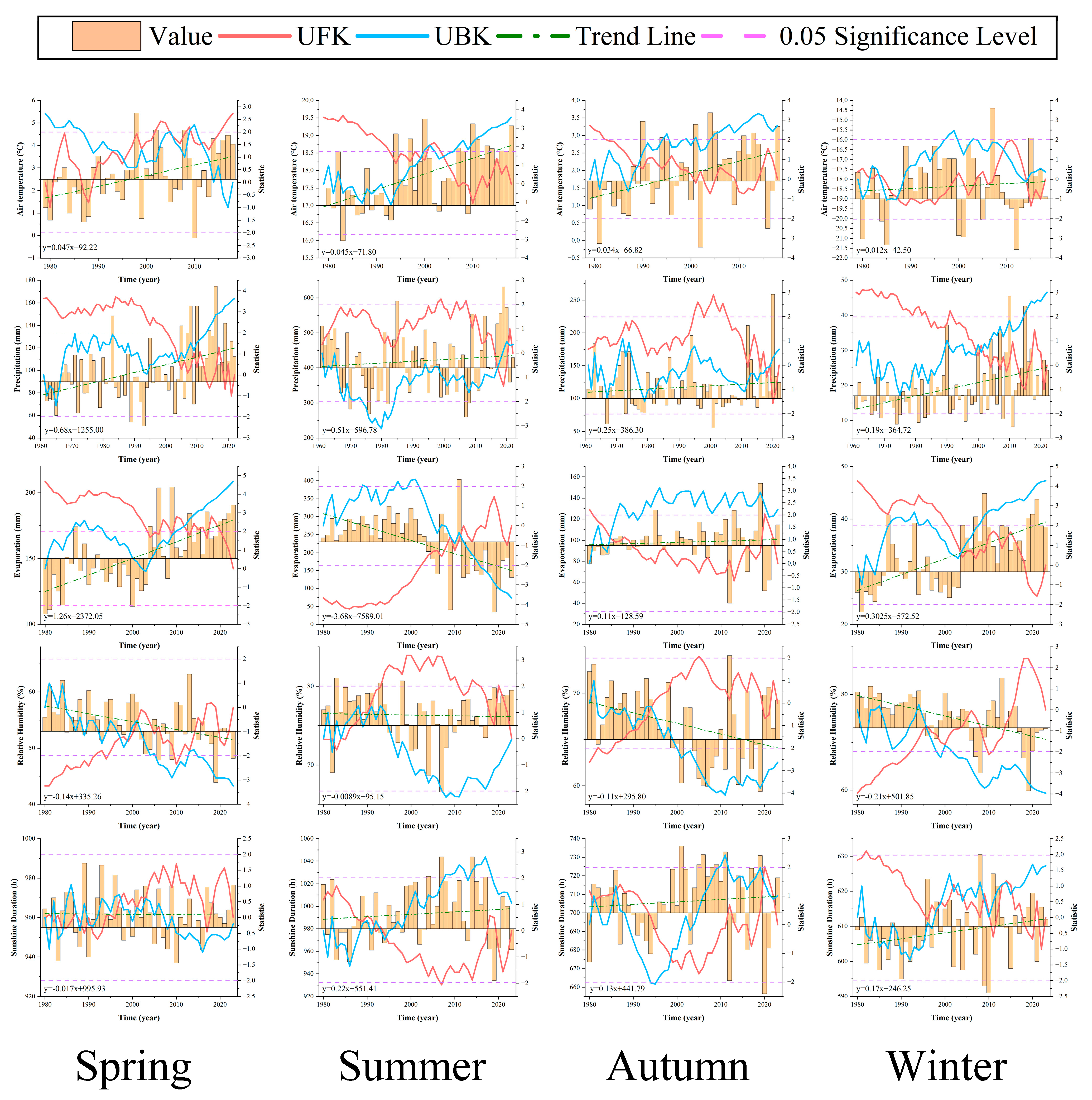

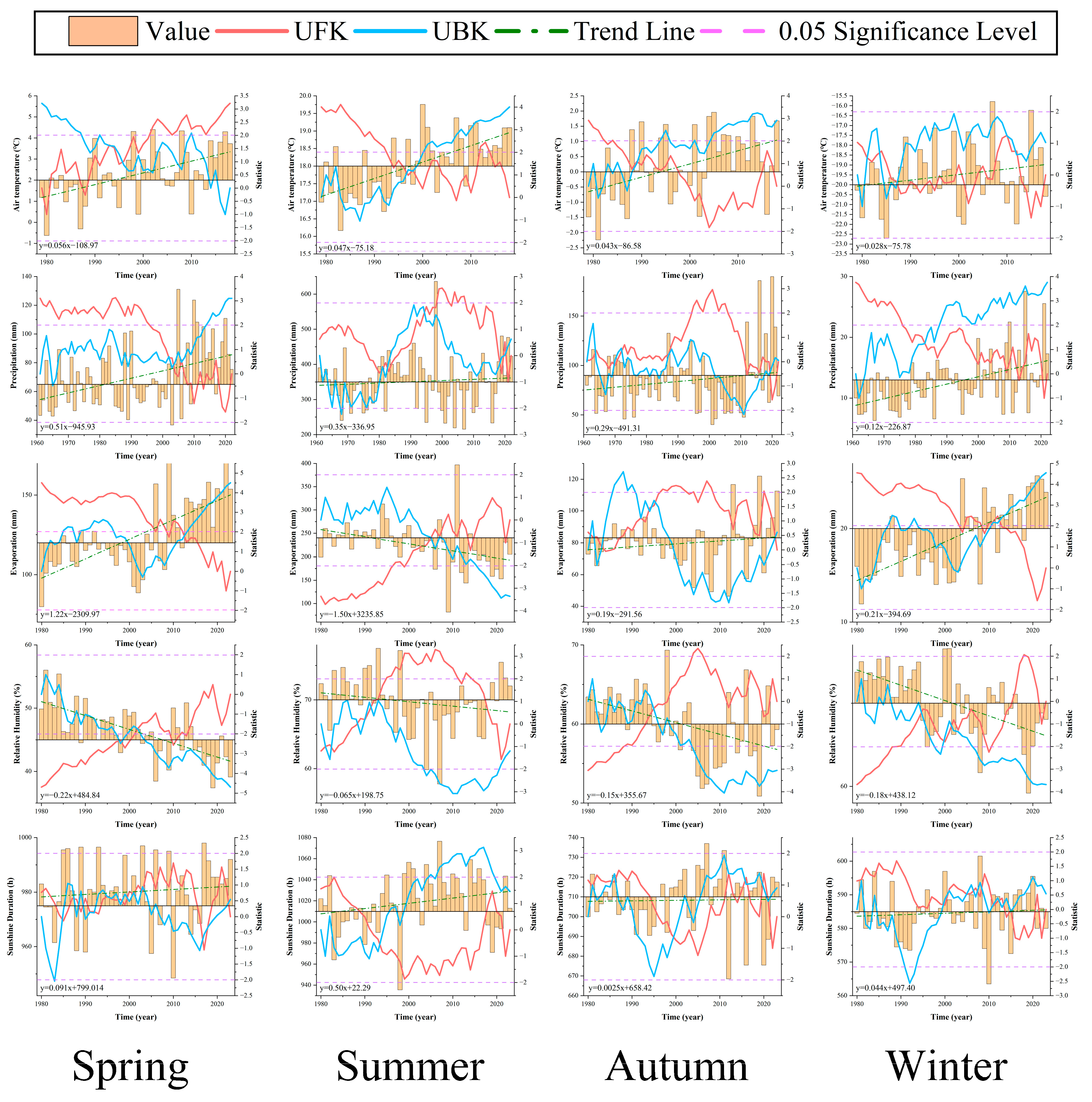
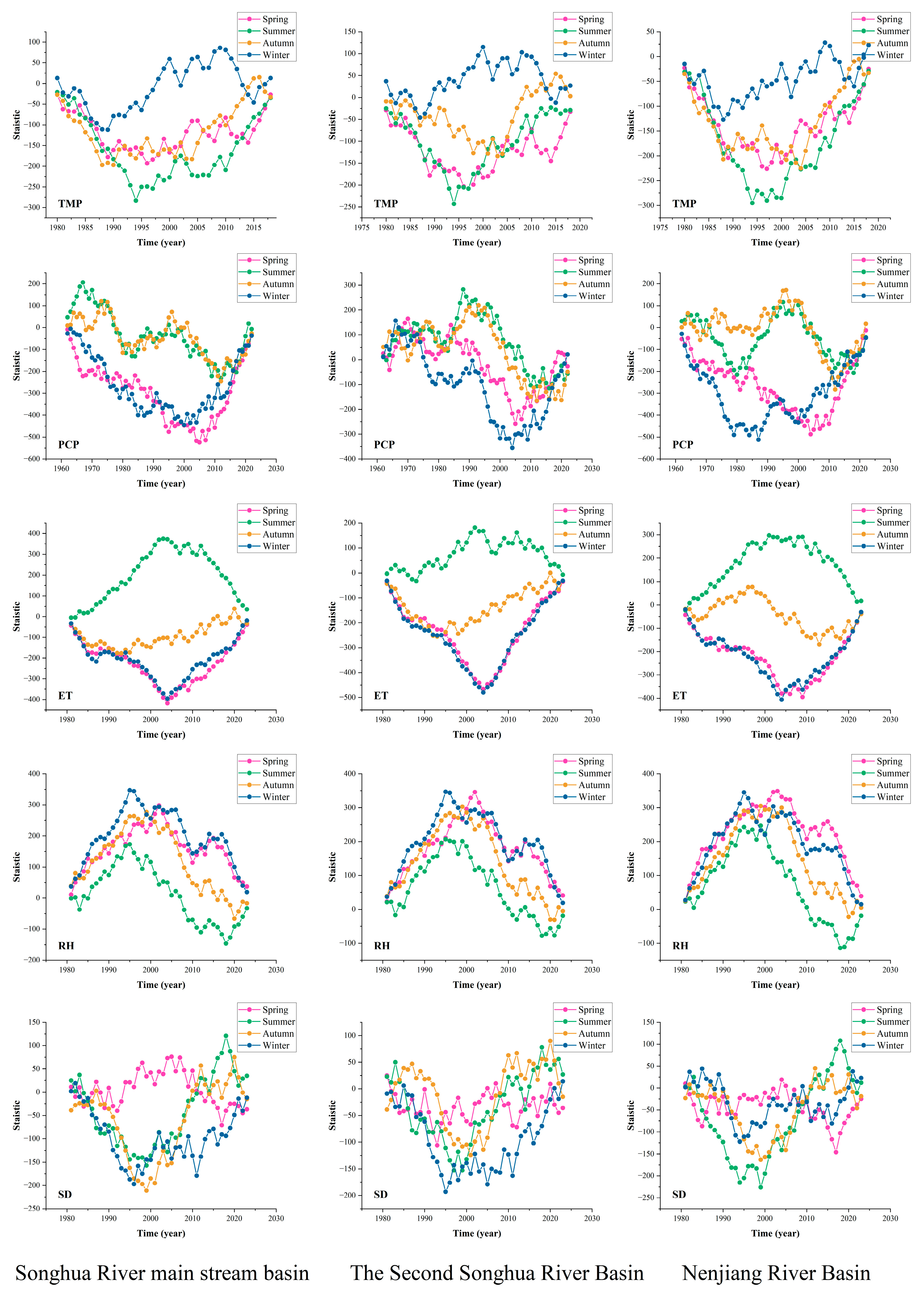
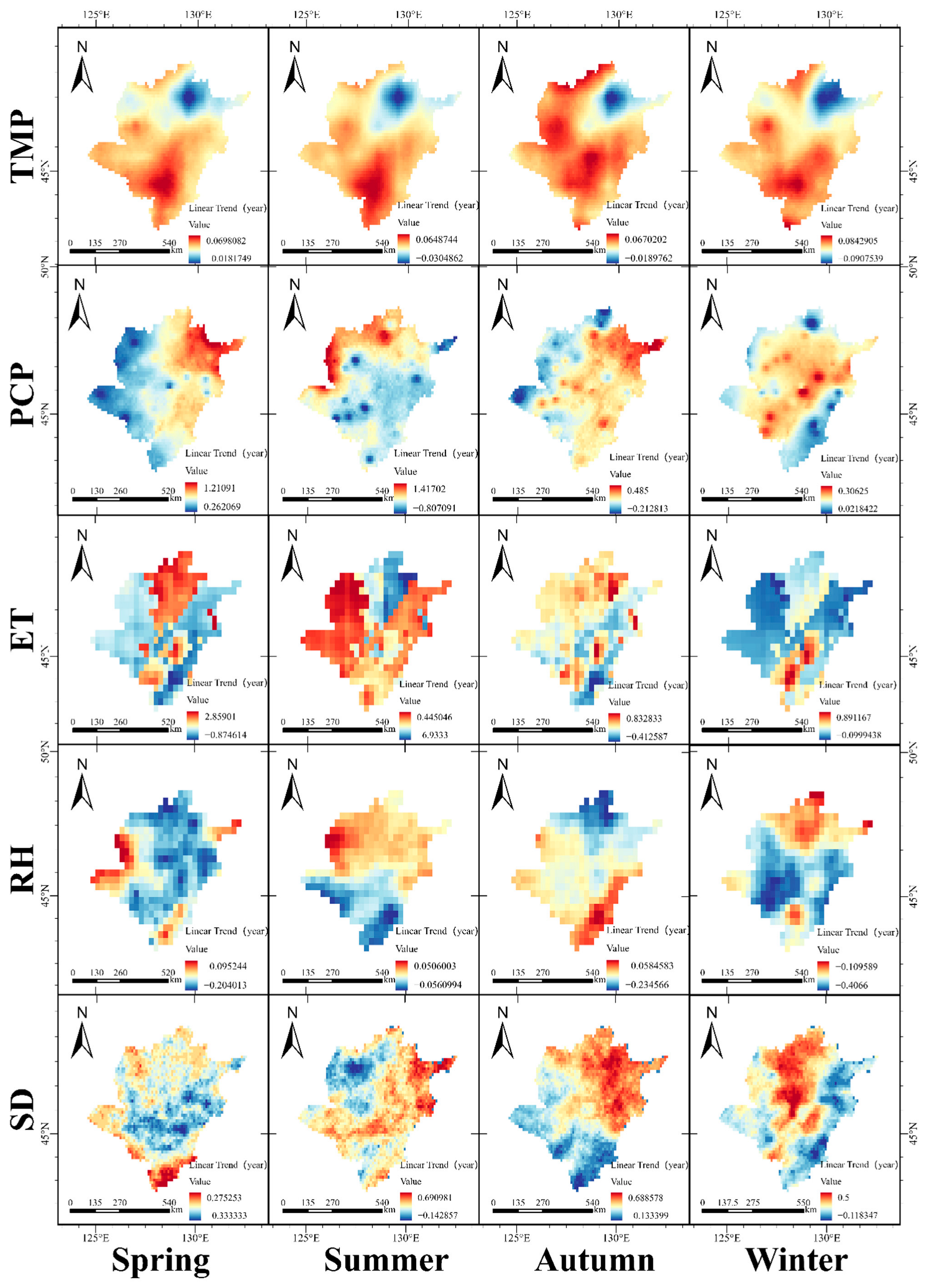
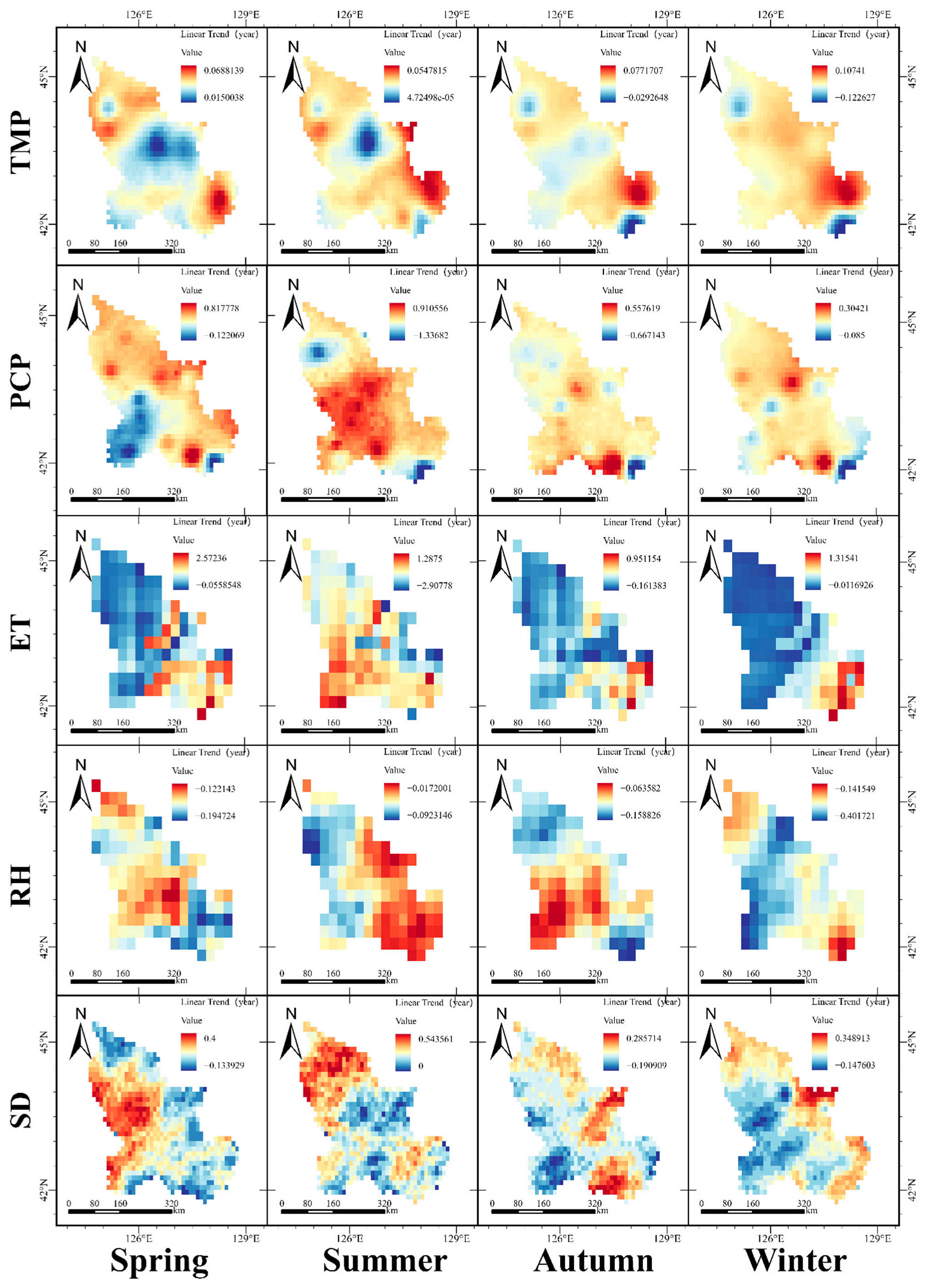

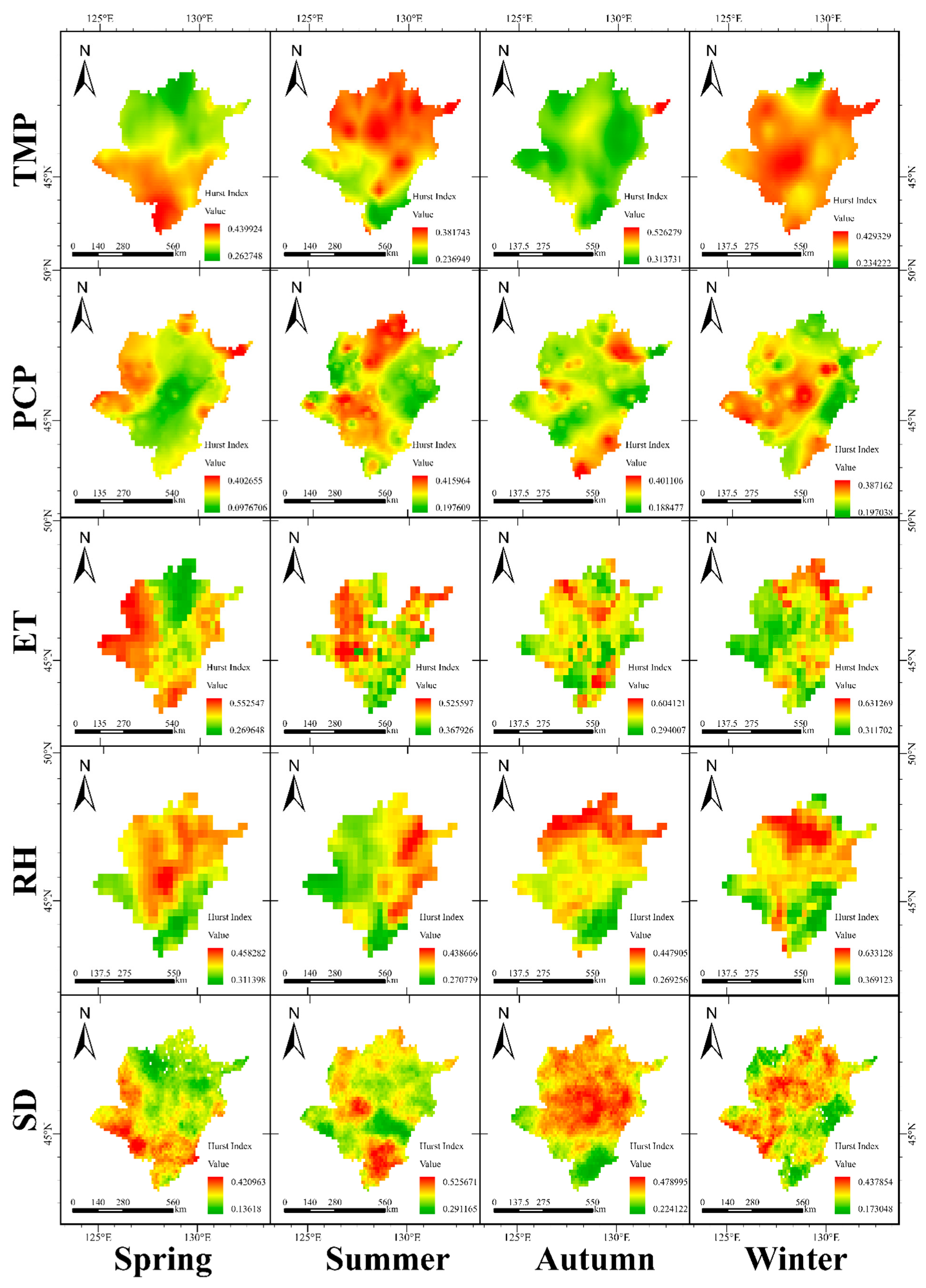
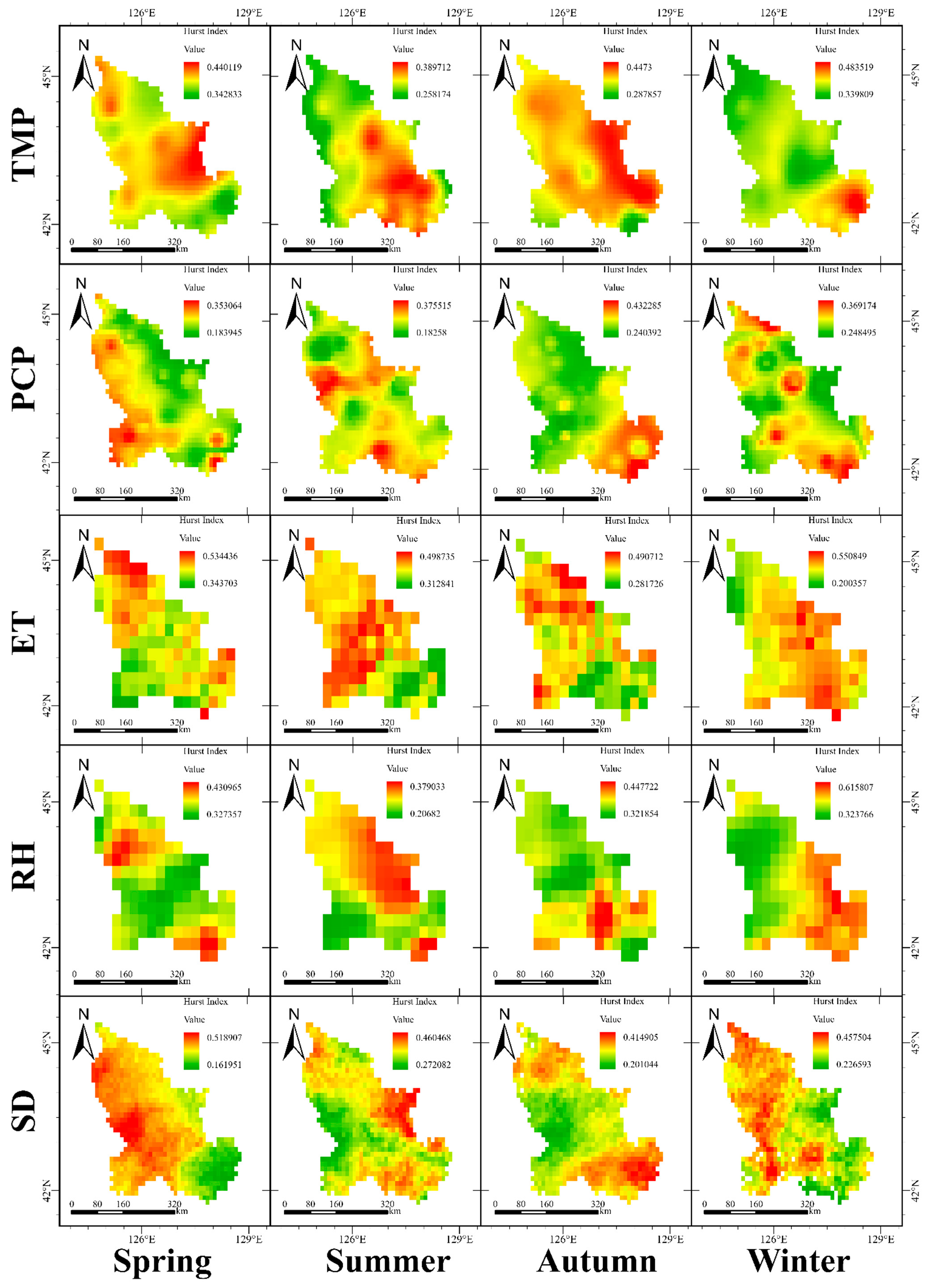





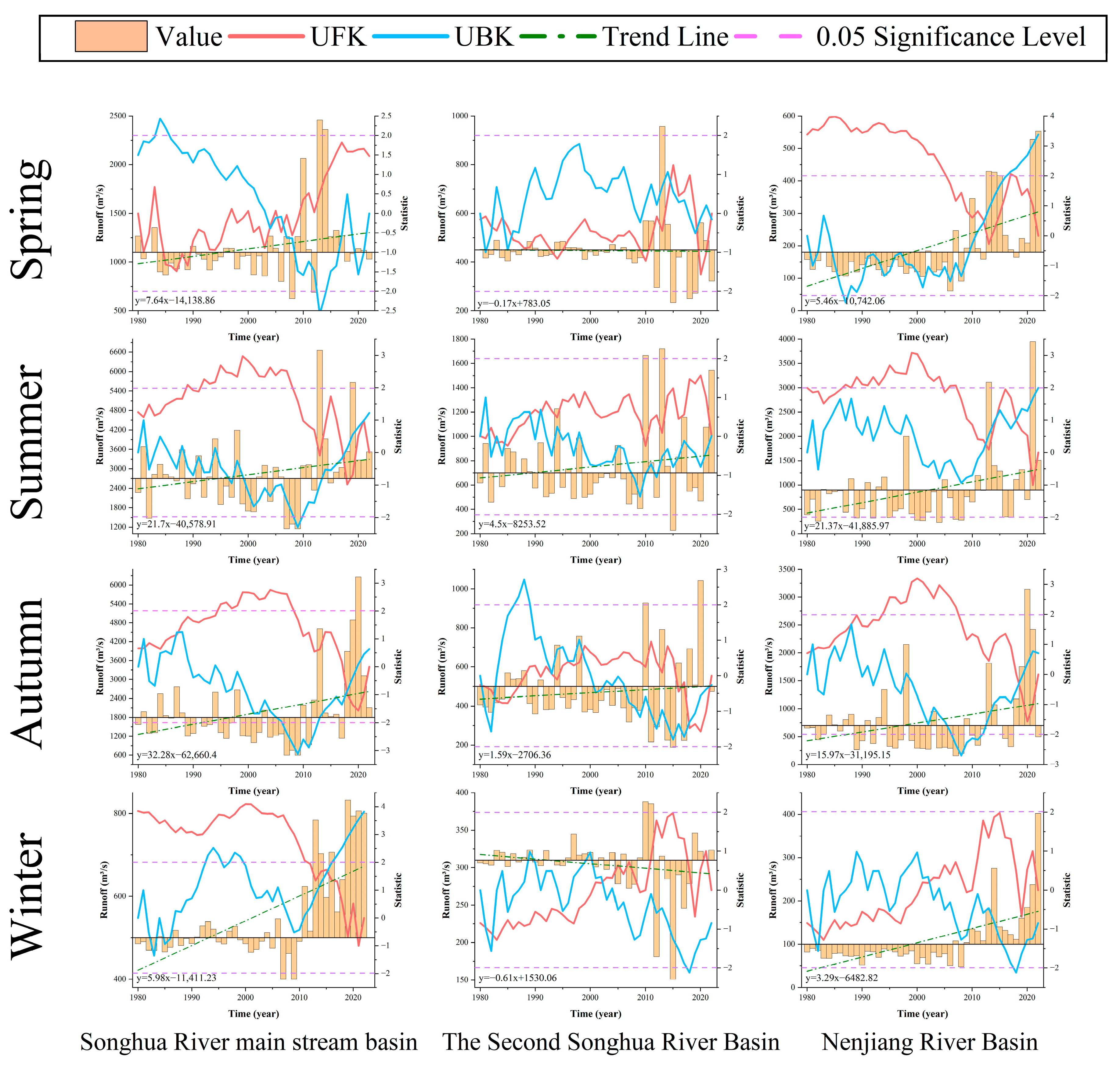




| Data Type | Data Name | Time Scale | Spatial Scale | Time Span | SOURCE |
|---|---|---|---|---|---|
| Meteorological data | Precipitation | Daily | 0.1° | 1980–2022 | https://data.tpdc.ac.cn/zh-hans/data/e5c335d9-cbb9-48a6-ba35-d67dd614bb8c (accessed on 1 July 2025) |
| Average temperature | Daily | 0.1° | 1980–2018 | https://data.tpdc.ac.cn/zh-hans/data/daa58689-a6d2-46cf-90fc-b73014ecef9d (accessed on 1 July 2025) | |
| Relative humidity | Daily | 0.1° | 1980–2022 | https://cds.climate.copernicus.eu (accessed on 1 July 2025) | |
| Evaporation | Daily | 0.1° | 1980–2022 | https://cds.climate.copernicus.eu (accessed on 1 July 2025) | |
| Sunshine hours | Daily | 0.1° | 1980–2022 | https://cds.climate.copernicus.eu (accessed on 1 July 2025) | |
| Hydrological data | Run off | Daily | station data | 1980–2022 | Actual measurement data from 12 hydrological stations in the Songhua River Basin, including Harbin, Jiamusi, Lanxi, Jilin, Fuyu, Dalai, Jiangqiao, Liujiatun, Dedu, Guchengzi, Yanqiao, and Nianzishan |
| Basin | Meteorological Factor | Season | Mk Test to Determine the Abrupt Change Period | Pettitt Abrupt Change Detection |
|---|---|---|---|---|
| Songhua River main stream basin | Average temperature | Spring | 1993/1999 | 1996 |
| Summer | 1992–2004 | 1993 | ||
| Autumn | 1989 | |||
| Winter | 1982–2009 | 1988 | ||
| Precipitation | Spring | 2004 | ||
| Summer | 2010–2022 | 2011 | ||
| Autumn | 2010–2019 | 2011 | ||
| Winter | 1999–2001 | 1999 | ||
| Evaporation | Spring | 2009 | ||
| Summer | 2000–2011 | 2002 | ||
| Autumn | 1984 | |||
| Winter | 2004 | |||
| Relative Humidity | Spring | 1997–2000 | 2001 | |
| Summer | 1980–1998 | 1994 | ||
| Autumn | 1994 | |||
| Winter | 1996 | |||
| Sunshine Hours | Spring | 1980–2007 | 2004 | |
| Summer | 1992–1999 | 1998 | ||
| Autumn | 1999 | |||
| Winter | 1998–2004 | 1995 | ||
| The Second Songhua River Basin | Average temperature | Spring | 1996–2000 | 1996 |
| Summer | 1993 | |||
| Autumn | 1997–2017 | 2002 | ||
| Winter | 1981–2005 | 1999 | ||
| Precipitation | Spring | 2003–2013 | 2004 | |
| Summer | 1968–1988 | 1987 | ||
| Autumn | 1975–2000 | 1992 | ||
| Winter | 2001–2012 | 2003 | ||
| Evaporation | Spring | 2003 | ||
| Summer | 2000–2015 | 2001 | ||
| Autumn | 1989–1993 | 1992 | ||
| Winter | 2003 | 2003 | ||
| Relative Humidity | Spring | 2001 | 2001 | |
| Summer | 1982–1994 | 1994 | ||
| Autumn | 1994 | |||
| Winter | 1990–1995 | 1994 | ||
| Sunshine Hours | Spring | 1990–1995 | 1992 | |
| Summer | 1993–1996 | 1996 | ||
| Autumn | 2001 | |||
| Winter | 1994–2001 | 1994 | ||
| Nenjiang River Basin | Average temperature | Spring | 1993–1996 | 1996 |
| Summer | 1992–1998 | 1993 | ||
| Autumn | 1989 | |||
| Winter | 1987 | |||
| Precipitation | Spring | 2002–2006 | 2003 | |
| Summer | 1981–2020 | 1979 | ||
| Autumn | 1988–2019 | 2011 | ||
| Winter | 1983 | |||
| Evaporation | Spring | 2013 | ||
| Summer | 2000–2007 | 2000 | ||
| Autumn | 1996–2013 | 2012 | ||
| Winter | 2002–2013 | 2003 | ||
| Relative Humidity | Spring | 1998–2002 | 2002 | |
| Summer | 1988–1998 | 1998 | ||
| Autumn | 1995 | |||
| Winter | 1994–2002 | 1994 | ||
| Sunshine Hours | Spring | 2003–2017 | 2016 | |
| Summer | 1996–1998 | 1998 | ||
| Autumn | 1999 | |||
| Winter | 1981–2000 | 1993 |
| Basin | Factor | Season | Mk Test to Determine the Abrupt Change Period | Pettitt Abrupt Change Detection |
|---|---|---|---|---|
| Songhua River main stream basin | Runoff | Spring | 2004–2010 | 2009 |
| Summer | 2010–2017 | 2010 | ||
| Autumn | 2012–2018 | 2012 | ||
| Winter | 2015 | |||
| The Second Songhua River Basin | Runoff | Spring | 2014–2021 | 2015 |
| Summer | 1980–2010 | 2010 | ||
| Autumn | 1998–2018 | 2018 | ||
| Winter | 2002 | |||
| Nenjiang River Basin | Runoff | Spring | 2012 | |
| Summer | 2011–2018 | 2011 | ||
| Autumn | 1988–2018 | 2012 | ||
| Winter | 2002 |
| Basin | Season | Mutation Year | The Cause of the Mutation | ||||||
|---|---|---|---|---|---|---|---|---|---|
| Songhua River main stream basin | Spring | 2009 | 1.001 | −0.001 | −0.011 | 102.211 | 0.086 | −2.297 | Climate change |
| Summer | 2010 | 1.659 | −0.659 | −0.341 | −388.174 | 73.284 | 414.890 | Human activities | |
| Autumn | 2012 | 1.234 | −0.234 | 0 | 87.323 | 12.678 | 0.000 | Climate change | |
| Winter | 2015 | 1.1012 | −0.1012 | −0.3298 | 838.4204 | −2.9048 | −735.52 | Climate change | |
| The Second Songhua River Basin | Spring | 2015 | 1.10 | −0.10 | −0.42 | −0.04 | 1.46 | 98.58 | Human activities |
| Summer | 2010 | 1.000 | 0.000 | −0.005 | 96.478 | 0.004 | 3.518 | Climate change | |
| Autumn | 2018 | 1.000 | 0.000 | −0.006 | 100.017 | −0.017 | 0.000 | Climate change | |
| Winter | 2002 | 1.00061 | −0.00061 | −0.0087 | 100.105 | −0.105 | 0 | Climate change | |
| Nenjiang River Basin | Spring | 2012 | 1.70 | −0.70 | −1.197 | 6.85 | −1.62 | 94.77 | Human activities |
| Summer | 2011 | 1.29 | −0.29 | −0.71 | −253.80 | −192.38 | 546.18 | Human activities | |
| Autumn | 2012 | 1.474 | −0.474 | 0.000 | 83.707 | 16.350 | −0.058 | Climate change | |
| Winter | 2002 | 1.000 | 0.000 | −0.007 | 99.839 | 0.161 | 0.000 | Climate change |
Disclaimer/Publisher’s Note: The statements, opinions and data contained in all publications are solely those of the individual author(s) and contributor(s) and not of MDPI and/or the editor(s). MDPI and/or the editor(s) disclaim responsibility for any injury to people or property resulting from any ideas, methods, instructions or products referred to in the content. |
© 2025 by the authors. Licensee MDPI, Basel, Switzerland. This article is an open access article distributed under the terms and conditions of the Creative Commons Attribution (CC BY) license (https://creativecommons.org/licenses/by/4.0/).
Share and Cite
Wang, X.; Dai, C.; Liu, G.; Meng, X.; Lu, P.; Pang, B. Climate Trends and Attribution Analysis of Runoff Changes in the Songhua River Basin from 1980 to 2022 Based on the Budyko Hypothesis. Sustainability 2025, 17, 8459. https://doi.org/10.3390/su17188459
Wang X, Dai C, Liu G, Meng X, Lu P, Pang B. Climate Trends and Attribution Analysis of Runoff Changes in the Songhua River Basin from 1980 to 2022 Based on the Budyko Hypothesis. Sustainability. 2025; 17(18):8459. https://doi.org/10.3390/su17188459
Chicago/Turabian StyleWang, Xinyu, Changlei Dai, Gengwei Liu, Xiang Meng, Pengfei Lu, and Bo Pang. 2025. "Climate Trends and Attribution Analysis of Runoff Changes in the Songhua River Basin from 1980 to 2022 Based on the Budyko Hypothesis" Sustainability 17, no. 18: 8459. https://doi.org/10.3390/su17188459
APA StyleWang, X., Dai, C., Liu, G., Meng, X., Lu, P., & Pang, B. (2025). Climate Trends and Attribution Analysis of Runoff Changes in the Songhua River Basin from 1980 to 2022 Based on the Budyko Hypothesis. Sustainability, 17(18), 8459. https://doi.org/10.3390/su17188459






